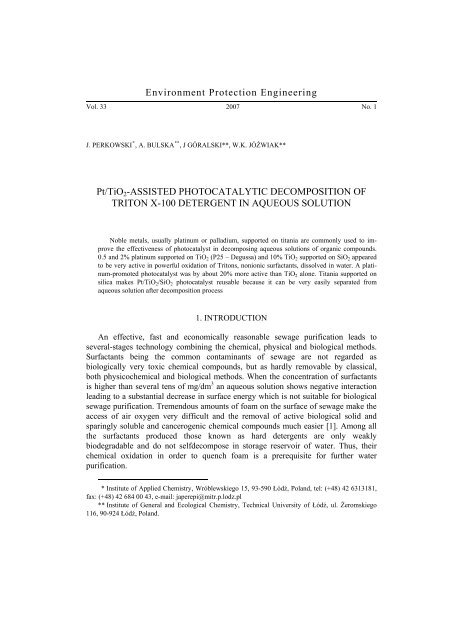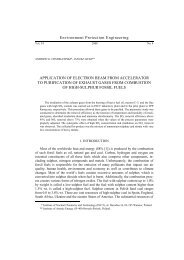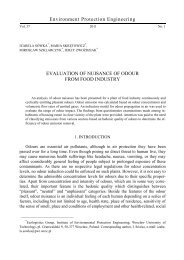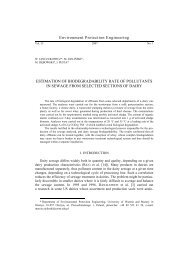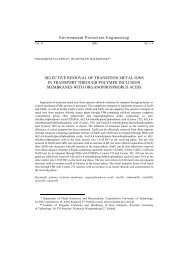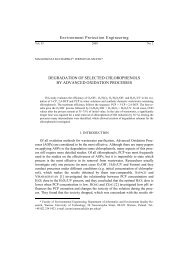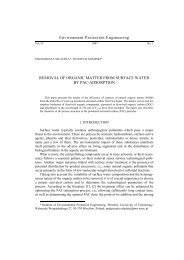Pt/TiO2-assisted photocatalytic decomposition of Triton X-100 ...
Pt/TiO2-assisted photocatalytic decomposition of Triton X-100 ...
Pt/TiO2-assisted photocatalytic decomposition of Triton X-100 ...
You also want an ePaper? Increase the reach of your titles
YUMPU automatically turns print PDFs into web optimized ePapers that Google loves.
Environment Protection Engineering<br />
Vol. 33 2007 No. 1<br />
J. PERKOWSKI * , A. BULSKA ** , J GÓRALSKI**, W.K. JÓŹWIAK**<br />
<strong>Pt</strong>/<strong>TiO2</strong>-ASSISTED PHOTOCATALYTIC DECOMPOSITION OF<br />
TRITON X-<strong>100</strong> DETERGENT IN AQUEOUS SOLUTION<br />
Noble metals, usually platinum or palladium, supported on titania are commonly used to improve<br />
the effectiveness <strong>of</strong> photocatalyst in decomposing aqueous solutions <strong>of</strong> organic compounds.<br />
0.5 and 2% platinum supported on TiO 2 (P25 – Degussa) and 10% TiO 2 supported on SiO 2 appeared<br />
to be very active in powerful oxidation <strong>of</strong> <strong>Triton</strong>s, nonionic surfactants, dissolved in water. A platinum-promoted<br />
photocatalyst was by about 20% more active than <strong>TiO2</strong> alone. Titania supported on<br />
silica makes <strong>Pt</strong>/TiO 2/SiO 2 photocatalyst reusable because it can be very easily separated from<br />
aqueous solution after <strong>decomposition</strong> process<br />
1. INTRODUCTION<br />
An effective, fast and economically reasonable sewage purification leads to<br />
several-stages technology combining the chemical, physical and biological methods.<br />
Surfactants being the common contaminants <strong>of</strong> sewage are not regarded as<br />
biologically very toxic chemical compounds, but as hardly removable by classical,<br />
both physicochemical and biological methods. When the concentration <strong>of</strong> surfactants<br />
is higher than several tens <strong>of</strong> mg/dm 3 an aqueous solution shows negative interaction<br />
leading to a substantial decrease in surface energy which is not suitable for biological<br />
sewage purification. Tremendous amounts <strong>of</strong> foam on the surface <strong>of</strong> sewage make the<br />
access <strong>of</strong> air oxygen very difficult and the removal <strong>of</strong> active biological solid and<br />
sparingly soluble and cancerogenic chemical compounds much easier [1]. Among all<br />
the surfactants produced those known as hard detergents are only weakly<br />
biodegradable and do not selfdecompose in storage reservoir <strong>of</strong> water. Thus, their<br />
chemical oxidation in order to quench foam is a prerequisite for further water<br />
purification.<br />
* Institute <strong>of</strong> Applied Chemistry, Wróblewskiego 15, 93-590 Łódź, Poland, tel: (+48) 42 6313181,<br />
fax: (+48) 42 684 00 43, e-mail: japerepi@mitr.p.lodz.pl<br />
** Institute <strong>of</strong> General and Ecological Chemistry, Technical University <strong>of</strong> Łódź, ul. Żeromskiego<br />
116, 90-924 Łódź, Poland.
130<br />
J. PERKOWSKI et al.<br />
One <strong>of</strong> the most efficient purification methods is the oxidation process combined<br />
with the use <strong>of</strong> photocatalysts. This method is based on a modern chemical technology<br />
<strong>of</strong> sewage and water treatment known as AOP (advanced oxidation process). In such a<br />
process, hydroxyl radicals (HO˙) that evolve in different ways are exceedingly<br />
reactive. If <strong>TiO2</strong> surface is exposed to the radiation <strong>of</strong> minimum energy <strong>of</strong> 3.2 eV,<br />
photon (hv) can transfer an electron ( ) from the valence band <strong>of</strong> crystal to the<br />
conduction band leaving an electron hole ( ). This energy is equivalent to energy <strong>of</strong><br />
the photons with the wavelength <strong>of</strong> 388 nm. The activation <strong>of</strong> <strong>TiO2</strong> takes place in the<br />
radiation range <strong>of</strong> 300–388 nm. Both, the holes <strong>of</strong> valence band and the electrons <strong>of</strong><br />
conduction band can recombine in crystal network, resulting in fluorescence and heat<br />
evolution effects and they can migrate on a catalyst surface, where they can be<br />
involved in redox reactions with adsorbed water molecules, hydroxyl groups (OH – ),<br />
oxygen atoms and the molecules <strong>of</strong> organic compounds. The hydroxyl groups are<br />
produced as a result <strong>of</strong> oxidation between the hole ( ) and H2O molecule or OH<br />
group. Electron can react with adsorbed O2(aq) generating , which additionally can<br />
give H2O2 and HO • −<br />
ecb<br />
h<br />
[2], [3].<br />
+<br />
vb<br />
+<br />
hvb<br />
−<br />
O2<br />
The pretreated wastewater can be entirely purified in fast, efficient and pr<strong>of</strong>itable<br />
biological process. Many compounds, e.g., phenols, chlorobenzene, chloromethanes,<br />
pesticides, dyes and different type detergents, may be subjected to <strong>photocatalytic</strong><br />
oxidation [4]–[7]. Most papers are focused on the parameters <strong>of</strong> <strong>photocatalytic</strong><br />
optimization. The parameters that delay applying this process are: rather low<br />
efficiency <strong>of</strong> photon-induced hydroxyl radicals generation and the necessity <strong>of</strong><br />
ultraviolet radiation. More effective photocatalysts working in the range <strong>of</strong> visible<br />
light are necessary as they make an industrial application <strong>of</strong> the sun or an inexpensive<br />
lamp radiation economically acceptable.<br />
Up till now the most <strong>of</strong> laboratory investigations were performed in low-capacity<br />
reactors (about 1 dm 3 ) with UV lamps <strong>of</strong> several hunderds wats. <strong>TiO2</strong> (P25 Degussa)<br />
photocatalyst was added to form the suspension with aqueous solution which was<br />
constantly mixed by the bubles <strong>of</strong> oxygen stream or rotator. Special methods <strong>of</strong> <strong>TiO2</strong><br />
separation are usually required: micr<strong>of</strong>iltration or centrifuging; their industrial<br />
application increases the costs <strong>of</strong> the treatment process. In order to solve this problem,<br />
<strong>TiO2</strong> can be dispersed on the great surface <strong>of</strong> silica powder particles, spheres or<br />
interior surface <strong>of</strong> teflon and glassy fibres [8], [9]. Platinum-promoted photocatalysts<br />
are more active than <strong>TiO2</strong> alone. Degussa 5% <strong>Pt</strong>/<strong>TiO2</strong> catalyst was 2.1 and 1.4 times<br />
more active than <strong>TiO2</strong> alone in dichloracetic acid and p-chlorophenol <strong>decomposition</strong>,<br />
respectively. In the same conditions also Sachtleben Hombikat 0.2% <strong>Pt</strong>/<strong>TiO2</strong> UV <strong>100</strong><br />
catalyst was 1.4 and 1.2 times more active [10]. 0.1–10% palladium photocatalysts<br />
appeared to be active in oxidation <strong>of</strong> many compounds [11]. SIEMON et al. [12] used<br />
0.2–0.5% <strong>Pt</strong>/<strong>TiO2</strong> catalysts for the reduction <strong>of</strong> Cr ions and EDTA <strong>decomposition</strong>.
<strong>Pt</strong>/TiO 2-<strong>assisted</strong> <strong>photocatalytic</strong> <strong>decomposition</strong> <strong>of</strong> <strong>Triton</strong> X-<strong>100</strong> 131<br />
SURI et al. [13] found that destruction <strong>of</strong> organic contaminants was 6 times higher,<br />
whereas ZHANG et al. [6] claimed that degradation <strong>of</strong> pollutants was 16 times higher<br />
in the presence <strong>of</strong> <strong>Pt</strong>/<strong>TiO2</strong>/SiO2 catalyst.<br />
2. EXPERIMENTAL<br />
2.1. COMPOUNDS SUBJECTED TO DEGRADATION<br />
The aqueous solutions <strong>of</strong> ethyloetoxylated alkylophenol, known as commercial<br />
surfactant <strong>Triton</strong> X-<strong>100</strong>, were degraded in AOP. <strong>Triton</strong> is a product <strong>of</strong> ethylene oxide<br />
condensation with p-1,1,3,3 tertmethylobuthylophenol (Fluka Chemie A.g.) being<br />
a mixture <strong>of</strong> oligomers with characteristic chain length distribution for n = 9.5.<br />
CH 3<br />
CH 3<br />
CH 3<br />
CH 3<br />
C CH 2 C O<br />
CH 3<br />
(CH 2 CH 2 O) n H<br />
The investigations presented in this paper are focused on the activity <strong>of</strong><br />
<strong>Pt</strong>/<strong>TiO2</strong>/SiO2 photocatalyst system in the oxidation <strong>of</strong> <strong>Triton</strong>s, nonionic surfactants<br />
dissolved in water. The problem <strong>of</strong> catalyst separation and its reuse optimalization is<br />
examined as well. The following catalysts were used:<br />
Titanium dioxide – <strong>TiO2</strong> (P25 – Degussa).<br />
Platinum-promoted titania – 0.5% <strong>Pt</strong>/<strong>TiO2</strong>, 2% <strong>Pt</strong>/<strong>TiO2</strong>.<br />
Titania supported on silica – 10% <strong>TiO2</strong>/SiO2.<br />
Platinum-promoted titania supported on silica – 0.5% <strong>Pt</strong>/ 10% <strong>TiO2</strong>/SiO2, 2% <strong>Pt</strong>/<br />
10% <strong>TiO2</strong>/SiO2.<br />
2.2. CATALYST PREPARATION<br />
Silica support was obtained by sol–gel method using tertetoxytitanium(IV) as<br />
an initial compound [14]. Titania supported on silica (10% <strong>TiO2</strong>/SiO2) was prepared<br />
by <strong>TiO2</strong> deposition on silica suspended in hexane solution <strong>of</strong> titanium isopropanol<br />
as a result <strong>of</strong> the hydrolysis <strong>of</strong> the latter in argon atmosphere and left for<br />
48 hours at room temperature. Then solvent was removed in vacuum and the catalyst<br />
was dried at 120 ºC for 4 h and finally calcined for 3 hours at 400 ºC in oxygen<br />
stream.
132<br />
J. PERKOWSKI et al.<br />
Platinum-supported catalysts, i.e., <strong>Pt</strong>/<strong>TiO2</strong> and <strong>Pt</strong>/10% <strong>TiO2</strong>/SiO2, were prepared<br />
by the support impregnation in aqueous solution <strong>of</strong> H2<strong>Pt</strong>Cl6. After being kept for 24<br />
hours at room temperature the catalysts were dried at 120 ºC for 4 hours and finally<br />
calcined for 3 hours at 200 ºC in oxygen stream [15]. The photocatalyst surface area<br />
and porosity measurements were carried out by BET (N2) method.<br />
2.3. TEMPERATURE– PROGRAMMED REDUCTION IN HYDROGEN (TPR H2)<br />
Temperature-programmed reduction (TPRH2) and temperature-programmed oxidation<br />
(TPO) measurements were carried out in an AMI1 system from Altamira Instruments<br />
(USA) equipped with thermal conductivity detector (TCD) and/or MS quadrupole<br />
mass spectrometer. In TPRH2 and TPO measurements, gaseous mixtures <strong>of</strong> 95%<br />
Ar–5% H2 and 98% Ar–2% O2, respectively, were used at the volume velocity <strong>of</strong> 60<br />
cm 3 min –1 and linear rise in the temperature <strong>of</strong> 15 °C·min –1 . TPRH2 measurements were<br />
carried out after fresh catalyst oxidation (O2, 3 hours) at the oxidation temperature <strong>of</strong><br />
500, 700 and 900 °C.<br />
2.4. ACTIVITY MEASUREMENTS AND ANALYTICAL PROCEDURE<br />
Photooxidation and <strong>photocatalytic</strong> processes were carried out in photoreactor (Heraous)<br />
consisting <strong>of</strong> a glass vessel (volume <strong>of</strong> <strong>100</strong>0 cm 3 ) equipped with UV150 W or 8<br />
W lamp placed in a quartz lining and magnetic rotor. The solution was supplied with<br />
oxygen via a special tube, and its constant volume velocity <strong>of</strong> 10 dm 3 h –1 was kept.<br />
Temperature <strong>of</strong> reaction usually reached about 20 °C. The known amount <strong>of</strong> photocatalyst<br />
was added to aqueous solution <strong>of</strong> <strong>Triton</strong> X-<strong>100</strong> before the experiment. The time<br />
<strong>of</strong> reaction ranged from 5 to 8 hours .<br />
The oxidation <strong>of</strong> <strong>Triton</strong> X-<strong>100</strong> aqueous solution was carried out in the system with<br />
the photocatalyst in the form <strong>of</strong> suspension. The course <strong>of</strong> reaction was controlled by<br />
spectrophotometeric method. The measurements <strong>of</strong> total organic carbon (TOC) were<br />
performed in 5000 Shimadzu device. The chemical and biochemical oxygen demand<br />
(COD and BOD) methods were also applied. A high-resolution liquid chromatography<br />
HRLC method was applied to follow the composition <strong>of</strong> individual detergents. The<br />
process was optimized based on the following parameters: the concentration and type<br />
<strong>of</strong> surfactant, the dose <strong>of</strong> surfactant, the photocatalyst mass, pH <strong>of</strong> solution, the radiation<br />
intensity, the reaction time and the possibility <strong>of</strong> reusing catalyst, a supportive<br />
action <strong>of</strong> O3, H2O2 and UV. All analytical procedures were carried out according to<br />
Polish Standards.
<strong>Pt</strong>/TiO 2-<strong>assisted</strong> <strong>photocatalytic</strong> <strong>decomposition</strong> <strong>of</strong> <strong>Triton</strong> X-<strong>100</strong> 133<br />
3. RESULTS<br />
3.1. SURFACE AREA<br />
The influence <strong>of</strong> oxidation temperature (200–700 °C) on the results <strong>of</strong> surface area<br />
measurements is presented in the table. An increase in the oxidation temperature from<br />
200 up to 700 °C results in a decrease in the surface area from about 50 to about 10<br />
m 2 /g, respectively. Platinum-supported catalysts have practically the same surface area<br />
as the supports themselves. A decrease <strong>of</strong> more than 10% in surface area is observed<br />
when SiO2 is compared with SiO2 covered with titania (10% <strong>TiO2</strong>/SiO2) which is a<br />
result <strong>of</strong> partial blocking <strong>of</strong> silica pores by titania. The diameter <strong>of</strong> pores that<br />
predominate decreases from 50 nm for SiO2 to about 40 nm for 10% <strong>TiO2</strong>/SiO2.<br />
Photocatalyst surface area<br />
Table<br />
Catalysts<br />
Surface area (m 2 /g)<br />
Temperature <strong>of</strong> oxidation (°C)<br />
200 300 400 500 600 700<br />
<strong>TiO2</strong> 50 45 42 31 11 9<br />
0.5% <strong>Pt</strong>/<strong>TiO2</strong> 49 30 9<br />
2% <strong>Pt</strong>/<strong>TiO2</strong> 49 43 40 29 10 10<br />
5% <strong>Pt</strong>/<strong>TiO2</strong> 40 25 8<br />
SiO2 426<br />
10% <strong>TiO2</strong>/ SiO2 382<br />
0.5% <strong>Pt</strong>/<strong>TiO2</strong>/SiO2 380<br />
2% <strong>Pt</strong>/<strong>TiO2</strong>/SiO2 363<br />
5% <strong>Pt</strong>/<strong>TiO2</strong>/SiO2 343<br />
3.2. TEMPERATURE-PROGRAMMED REDUCTION IN HYDROGEN<br />
The influence <strong>of</strong> oxidation temperatures <strong>of</strong> 500, 700 and 900 °C on TPRH2 pr<strong>of</strong>iles<br />
is presented in figures 1–4 for: <strong>TiO2</strong>, 10% <strong>TiO2</strong>/SiO2, 0.5% <strong>Pt</strong>/<strong>TiO2</strong>, 0.5% <strong>Pt</strong>/10%<br />
<strong>TiO2</strong>/SiO2 catalysts.<br />
For <strong>TiO2</strong> alone the reduction effects are relatively small and appear in a broad<br />
temperature range, i.e., 200–900 °C (figure 1). An increase in the oxidation tem-<br />
perature from 500 to 700 and finally 900 °C does not infuence very much the<br />
reduction behaviour <strong>of</strong> <strong>TiO2</strong> and leads to rather unsubstantial decrease in <strong>TiO2</strong><br />
reducibility caused by its sintering during the catalyst preoxidation at 700 and 900 °C,<br />
and the initial surface area <strong>of</strong> 50 m 2 /g decreased to about 9 and 8 m 2 /g, respectively.
134<br />
TCD Signal (a.u.)<br />
600<br />
500<br />
400<br />
300<br />
200<br />
<strong>100</strong><br />
J. PERKOWSKI et al.<br />
T calcination = 900°C<br />
T calcination = 700°C<br />
T calcination = 500°C<br />
0<br />
0 200 400 600 800 <strong>100</strong>0<br />
Temperature (°C)<br />
Fig. 1. The influence <strong>of</strong> temperature <strong>of</strong> oxidation (4 h, O 2) on TPR H2 pr<strong>of</strong>iles for TiO 2<br />
Titania belongs to nonstoichiometric and partly reducible oxides formulated as<br />
<strong>TiO2</strong>–x, where 0.5 ≥ x ≥ 0 greatly depends on the atmosphere and treatment temperature.<br />
In air, at 870 °C the phase transformation from anatase into rutile takes place<br />
[16]. Commercial titania P25 usually contains 20% <strong>of</strong> anatase and 80% <strong>of</strong> rutile.<br />
Hovewer, in hydrogen atmosphere, the temperature <strong>of</strong> phase transformation <strong>of</strong> the<br />
<strong>Pt</strong>/<strong>TiO2</strong> catalyst is considerably lower.<br />
TCD signal [a.u.]<br />
600<br />
500<br />
400<br />
300<br />
200<br />
<strong>100</strong><br />
T calcination = 900°C<br />
T calcination = 700°C<br />
T calcination = 500°C<br />
0<br />
0 200 400 600 800 <strong>100</strong>0<br />
Temperature [°C]<br />
Fig. 2. The influence <strong>of</strong> temperature <strong>of</strong> oxidation (4 h, O 2) on TPR H2 pr<strong>of</strong>iles for<br />
10% TiO 2/SiO 2 catalyst
<strong>Pt</strong>/TiO 2-<strong>assisted</strong> <strong>photocatalytic</strong> <strong>decomposition</strong> <strong>of</strong> <strong>Triton</strong> X-<strong>100</strong> 135<br />
The development <strong>of</strong> <strong>TiO2</strong> surface area by its dispersion on silica surface increases<br />
its reduction effects. After oxidation at 500 °C the reduction effects in the temperature<br />
range from 200 to 700 °C without any visible reduction maximum are presented in<br />
figure 2. The considerable changes in reduction behaviour can be noticed after oxidation<br />
at 700 °C – the beginning <strong>of</strong> reduction at higher temperature (350 °C) and welldefined<br />
maximum at about 800 °C. The amount <strong>of</strong> the hydrogen consumed is considerably<br />
higher than that after oxidation at 500 °C. The oxidation at still higher temperature,<br />
i.e., 900 °C, leads to a substantial decrease in reduction effects which is attributed<br />
to the sample sintering and phase transformation.<br />
Signal TCD [a.u.]<br />
600<br />
500<br />
400<br />
300<br />
200<br />
<strong>100</strong><br />
0<br />
T calcination =900°C<br />
T calcination = 700°C<br />
T calcination = 500°C<br />
0 200 400 600 800 <strong>100</strong>0<br />
Temperature [°C]<br />
Fig. 3. The influence <strong>of</strong> temperature <strong>of</strong> oxidation (4 h, O 2) on TPR H2 pr<strong>of</strong>iles<br />
for 0.5% <strong>Pt</strong>/TiO 2 catalyst<br />
Signal TCD [a.u.]<br />
600<br />
500<br />
400<br />
300<br />
200<br />
<strong>100</strong><br />
T calcination =900°C<br />
T calcination = 700°C<br />
T calcination = 500°C<br />
0<br />
0 200 400 600 800 <strong>100</strong>0<br />
Temperature [°C]<br />
Fig. 4. The influence <strong>of</strong> temperature <strong>of</strong> oxidation (4 h, O2) on TPR H2 pr<strong>of</strong>iles<br />
for 0.5% <strong>Pt</strong>/10% TiO 2/SiO 2 catalyst
136<br />
J. PERKOWSKI et al.<br />
Platinum (0.5% by weigh) supported on 10% <strong>TiO2</strong>/SiO2 surface increases considerably<br />
the consumption <strong>of</strong> hydrogen, especially after oxidation at 500 and 700 °C<br />
(see figure 4). In both cases, the reduction effect in the temperature range <strong>of</strong> 300–700<br />
°C can be assigned to platinum promoting titania reduction, <strong>TiO2</strong> + xH2 → <strong>TiO2</strong>–x.+<br />
xH2O. Oxidation at 900 °C leads to a substantial reduction <strong>of</strong> metal-support bridges<br />
<strong>Pt</strong>–O–Ti stabilized by chlorine present on titania surface and originating from H2<strong>Pt</strong>Cl6<br />
[17]–[20]. TPR peaks characteristic <strong>of</strong> chlorine-stabilized platinum oxide phase were<br />
not observed. High-temperature (900 °C) oxidation <strong>of</strong> <strong>Pt</strong>/<strong>TiO2</strong>/SiO2 catalyst can lead<br />
to irreducible type <strong>of</strong> crystalline structure (<strong>Pt</strong>TiO3) strongly dispersed on the catalyst<br />
surface or incorporated into bulk catalyst [20].<br />
Different character <strong>of</strong> reduction behaviour is shown in figure 3 for 0.5% <strong>Pt</strong>/ <strong>TiO2</strong> catalyst.<br />
After oxidation at 500 °C the low temperature peak in the range <strong>of</strong> 50–150 °C is<br />
attributed to chlorine-stabilized platinum oxide phase (<strong>Pt</strong>OxCly). The increase in the oxidation<br />
temperature to 700 °C gives the additional reduction effect with the maximum at<br />
about 600 °C. TPR pr<strong>of</strong>iles for 2% <strong>Pt</strong>/ <strong>TiO2</strong> and 2% <strong>Pt</strong>/<strong>TiO2</strong>/SiO2 catalysts appeared to<br />
be analogous to those that represent the catalyst containing 0.5% <strong>Pt</strong>.<br />
3.3. PHOTOCATALYTIC OXIDATION OF TRITON X-<strong>100</strong><br />
During <strong>photocatalytic</strong> oxidation <strong>of</strong> the aqueous solution <strong>of</strong> <strong>Triton</strong> X-<strong>100</strong> the following<br />
parameters were measured: solution pH, UV absorbance ratio (A/A0), total<br />
organic carbon (TOC), chemical and biochemical oxygen demand (COD and BOD5).<br />
In order to remove <strong>TiO2</strong>, the solution was filtered before analysis.<br />
<strong>100</strong><br />
90<br />
80<br />
70<br />
60<br />
50<br />
40<br />
30<br />
20<br />
10<br />
0<br />
1 h<br />
% A/A o<br />
3 h<br />
5 h<br />
% TOC/TOC o<br />
1,5 g/dm 3 <strong>TiO2</strong> 1,5 g/dm 3 10% <strong>TiO2</strong> /SiO2 3 g/dm 3 10% TiO 2 /SiO 2<br />
6 g/dm 3 10% TiO 2 /SiO 2<br />
1 h 5 h<br />
3 h<br />
% % ChZT/ChZT COD/COD o<br />
Fig. 5. The influence <strong>of</strong> photo<strong>decomposition</strong> parameters <strong>of</strong> <strong>Triton</strong> X-<strong>100</strong> water solution expressed as:<br />
A/A 0, TOC/TOC 0, COD/COD 0 in function <strong>of</strong> reaction time at different doses <strong>of</strong> 10% TiO 2/SiO 2<br />
catalyst (1.5, 3 and 6 mg/dm 3 ). The measurements were carried out using 150 W lamp<br />
and the initial surfactant concentration <strong>of</strong> 120 mg/dm 3<br />
3 h<br />
5 h
<strong>Pt</strong>/TiO 2-<strong>assisted</strong> <strong>photocatalytic</strong> <strong>decomposition</strong> <strong>of</strong> <strong>Triton</strong> X-<strong>100</strong> 137<br />
The influence <strong>of</strong> the reaction time on <strong>Triton</strong> X-<strong>100</strong> <strong>decomposition</strong> (A/A0, TOC/TOC0<br />
and COD/COD0) at different doses <strong>of</strong> 10% <strong>TiO2</strong>/SiO2 catalyst (1.5, 3 and 6 mg/dm 3 ) is<br />
presented in figure 5. The measurements were carried out using 120 W lamp and an<br />
initial surfactant concentration <strong>of</strong> 120 mg/dm 3 .<br />
The modified platinum-supported catalyst <strong>Pt</strong>/<strong>TiO2</strong> was powdered in mortar be-<br />
fore its use as photocatalyst for two initial concentrations <strong>of</strong> <strong>Triton</strong> X-<strong>100</strong> solutions<br />
(120 mg/dm 3 and 250 mg/dm 3 ) and the examples <strong>of</strong> the results obtained are presented<br />
in figure 6.<br />
% decrease <strong>of</strong> COD value<br />
% decrease <strong>of</strong> COD value<br />
50<br />
40<br />
30<br />
20<br />
10<br />
0<br />
50<br />
40<br />
30<br />
20<br />
10<br />
0<br />
3 h<br />
Concentration <strong>of</strong> <strong>Triton</strong> X - <strong>100</strong> = 250 mg/dm 3<br />
5 h<br />
2 g/dm 3 TiO 2<br />
2 g/dm 3 0,5% <strong>Pt</strong>/TiO 2<br />
2 g/dm 3 2% <strong>Pt</strong>/TiO 2<br />
1 h 3 h<br />
5 h<br />
Concentration <strong>of</strong> <strong>Triton</strong> X - <strong>100</strong> = 120 mg/dm 3<br />
3 h 5 h<br />
1 h<br />
3 h<br />
5 h<br />
Fig. 6. The absorbance ratio A/A 0 and chemical oxygen demand ratio COD/COD 0 for<br />
two <strong>Triton</strong> X-<strong>100</strong> water solutions (120 and 250 mg/dm 3 ) expressed as: A/A 0 TOC/TOC 0, COD/COD 0<br />
in function <strong>of</strong> reaction time at 2 mg/dm 3 dose <strong>of</strong> photocatalysts: TiO 2, 0.5% <strong>Pt</strong>/TiO 2<br />
and 2% <strong>Pt</strong>/TiO 2. The measurements were carried out using 150 W lamp<br />
Titania–silica (10% <strong>TiO2</strong>/SiO2) and platinum-supported (0.5% and 2% <strong>Pt</strong>/10%<br />
<strong>TiO2</strong>/SiO2) catalysts were tested in <strong>Triton</strong> X-<strong>100</strong> solution <strong>decomposition</strong>. The tests<br />
were carried out at the initial <strong>Triton</strong> X-<strong>100</strong> concentration <strong>of</strong> 120 mg/dm 3 and UV lamp<br />
<strong>of</strong> 150 W. The results obtained, i.e., the absorbance ratio (A/A0) and chemical oxygen<br />
demand ratio COD/COD0, are given in figure 7.<br />
% decrease <strong>of</strong> absorbance<br />
% decrease <strong>of</strong> absorbance
138<br />
% decrease <strong>of</strong> absorbance value<br />
<strong>100</strong><br />
90<br />
80<br />
70<br />
60<br />
50<br />
40<br />
30<br />
20<br />
10<br />
0<br />
1 h<br />
10% TiO 2 /SiO 2<br />
0.5 % <strong>Pt</strong>/10% TiO 2 /SiO 2<br />
2% <strong>Pt</strong>/10% TiO 2 /SiO 2<br />
3 h<br />
J. PERKOWSKI et al.<br />
5 h<br />
Fig. 7. The absorbance ratio A/A 0 and chemical oxygen demand ratio COD/COD 0 for titania–silica<br />
(10% TiO 2/SiO 2) and platinum-supported (0.5 and 2% <strong>Pt</strong>/10% TiO 2/SiO 2) catalysts.<br />
The measurements were carried out using: 150 W lamp, the photocatalyst dose <strong>of</strong> 1.5 g/dm 3<br />
and an initial surfactant concentration <strong>of</strong> 120 mg/dm 3<br />
% decrease <strong>of</strong> COD value<br />
<strong>100</strong><br />
80<br />
60<br />
40<br />
20<br />
0<br />
0 1 2 3 4 5 0 1<br />
time <strong>of</strong> reaction [h]<br />
2 3 4 5<br />
3 h<br />
TiO 2<br />
10% TiO 2 /SiO 2<br />
5 h<br />
0.5% <strong>Pt</strong>/TiO 2<br />
0.5% <strong>Pt</strong>/TiO 2 /SiO 2<br />
Fig. 8. The kinetic curves <strong>of</strong> the photocatalysts applied: TiO 2, 0.5% <strong>Pt</strong>/TiO 2, 10% TiO 2/SiO 2<br />
and 0.5% <strong>Pt</strong>/10% <strong>TiO2</strong>/SiO 2 during oxidation <strong>of</strong> <strong>Triton</strong> X-<strong>100</strong> aqueous solution. An initial surfactant<br />
concentration was 120 mg/dm 3 . The dose <strong>of</strong> photocatalyst was 2 g/dm 3 and UV lamp <strong>of</strong> 150 W was used<br />
The kinetic behaviour <strong>of</strong> such photocatalysts as <strong>TiO2</strong>, 0.5% <strong>Pt</strong>/<strong>TiO2</strong>, 10%<br />
<strong>TiO2</strong>/SiO2 and 0.5% <strong>Pt</strong>/<strong>TiO2</strong>/SiO2 is presented in figure 8. The initial surfactant con-<br />
% decrease <strong>of</strong> absorbance value<br />
% decrease <strong>of</strong> COD value
<strong>Pt</strong>/TiO 2-<strong>assisted</strong> <strong>photocatalytic</strong> <strong>decomposition</strong> <strong>of</strong> <strong>Triton</strong> X-<strong>100</strong> 139<br />
centration was 120 mg/dm 3 , the dose <strong>of</strong> photocatalyst reached 2 g/dm 3 and UV lamp<br />
<strong>of</strong> 150 W was used.<br />
During the <strong>Triton</strong> <strong>decomposition</strong> the surface <strong>of</strong> photocatalysts did not change at all.<br />
4. DISCUSSION<br />
Photocatalytic oxidation <strong>of</strong> the aqueous solution <strong>of</strong> <strong>Triton</strong> X-<strong>100</strong> was the subject<br />
<strong>of</strong> our previous study [21]. One <strong>of</strong> its disadvantages is a periodic character <strong>of</strong> photocatalyst<br />
suspension requiring titania separation after reaction completion. In order to<br />
resolve this problem, <strong>TiO2</strong> was dispersed on the silica support and the accessible surface<br />
<strong>of</strong> 50 m 2 /g was increased up to 380 m 2 /g. The initial material, i.e. silica, for 10%<br />
<strong>TiO2</strong>/SiO2 catalyst has grains in the range <strong>of</strong> 1–3 mm, but during <strong>TiO2</strong> deposition the<br />
catalyst grains stick together keeping a total surface area constant. This kind <strong>of</strong> catalyst<br />
makes separation fast and easy.<br />
The experiments in <strong>Triton</strong> X-<strong>100</strong> <strong>decomposition</strong> confirmed high catalytic activity<br />
<strong>of</strong> this catalyst due to its granulation. The optimal catalyst dose was 1.5 g <strong>of</strong> <strong>TiO2</strong> per<br />
one dm 3 <strong>of</strong> solution [21]. In the case <strong>of</strong> 10% <strong>TiO2</strong>/SiO2, the changes <strong>of</strong> the absorbance<br />
(A), chemical oxygen demand (COD) and total organic carbon (TOC) lead to the conclusion<br />
that pure <strong>TiO2</strong> faster decomposes <strong>Triton</strong> X-<strong>100</strong> than the same dose <strong>of</strong><br />
<strong>TiO2</strong>/SiO2 catalyst. The differences in the absorbance, COD and TOC values range<br />
from 12% after one hour up to 37% after 5 hours <strong>of</strong> reaction (see figure 5). Better<br />
results are obtained at high loading <strong>of</strong> photocatalyst. At the catalyst 10% <strong>TiO2</strong>/SiO2<br />
dose <strong>of</strong> 3 g/dm 3 higher values <strong>of</strong> COD and TOC reduction are obtained, whereas at its<br />
dose <strong>of</strong> 6 g/dm 3 the differences approach 20% after 5 hours <strong>of</strong> reaction. The changes<br />
<strong>of</strong> absorbance λ = 224 nm, being cumulative measure <strong>of</strong> <strong>Triton</strong> X-<strong>100</strong> and unsaturated<br />
and aromatic compounds, are similar for both <strong>TiO2</strong> and 10% <strong>TiO2</strong>/SiO2 catalysts. The<br />
preparation <strong>of</strong> 10% <strong>TiO2</strong>/SiO2 catalyst is easier because surfactant molecules undergo<br />
deep <strong>decomposition</strong> on interior surface <strong>of</strong> silica pores before the final products are<br />
desorbed to liquid phase. Different pathway is postulated on the surface <strong>of</strong> <strong>TiO2</strong> catalyst,<br />
where after primary adsorption–oxidation stage a desorption takes place and in<br />
turn successive adsorption <strong>of</strong> subsequent surfactant molecules follows.<br />
In order to improve photocatalyst activity, both <strong>TiO2</strong> and 10% <strong>TiO2</strong>/SiO2 catalysts<br />
were additionally platinum-promoted (0.5 and 2 wt %). Platinum-modified titania<br />
does not change practically its surface area <strong>of</strong> about 49 m 2 /g in comparison with that<br />
characteristic <strong>of</strong> <strong>TiO2</strong> alone, i.e., 50 m 2 /g (see the table). A decrease more than 10% in<br />
surface area is observed when SiO2 itself is compared with silica covered with titania<br />
(10% <strong>TiO2</strong>/SiO2) which is a result <strong>of</strong> partial blocking <strong>of</strong> silica pores by titania.<br />
The diameter <strong>of</strong> pores that predominate decreases from 50 nm for SiO2 to about<br />
40 nm for 10% <strong>TiO2</strong>/SiO2. The 10% <strong>TiO2</strong>/SiO2 photocatalysts obtained have much
140<br />
J. PERKOWSKI et al.<br />
higher bulk density and even after mechanical powdering the density was three times<br />
higher than that characteristic <strong>of</strong> pure titania.<br />
<strong>Pt</strong>/<strong>TiO2</strong> catalysts <strong>of</strong> lower metal loading (0.5% <strong>Pt</strong>) appeared to be more active than<br />
catalyst containing 2% <strong>Pt</strong> (figure 6). After 5-hour oxidation <strong>of</strong> <strong>Triton</strong> X-<strong>100</strong> in an initial<br />
concentration <strong>of</strong> 120 mg/dm 3 in the presence <strong>of</strong> 0.5% <strong>Pt</strong>/<strong>TiO2</strong> catalyst the reduction <strong>of</strong><br />
COD value was <strong>100</strong>%, whereas 85% reduction was measured for 2% <strong>Pt</strong>/<strong>TiO2</strong> and 79%<br />
for <strong>TiO2</strong> alone. The same dependence is observed for more concentrated solution <strong>of</strong> the<br />
surfactant (250 mg/dm 3 ) which seems to confirm that micellar form <strong>of</strong> <strong>Triton</strong> X-<strong>100</strong><br />
does not influence its <strong>decomposition</strong>. After 5 hours <strong>of</strong> reaction almost 90% reduction <strong>of</strong><br />
COD was observed due to UV radiation <strong>of</strong> more powerful 150 W lamp.<br />
In the case <strong>of</strong> platinum supported on titania/silica, higher activity was found for<br />
2% <strong>Pt</strong>/10% <strong>TiO2</strong>/SiO2 catalyst, especially in an initial period <strong>of</strong> reaction. One can<br />
suppose that destruction <strong>of</strong> aromatic ring is equivalent to <strong>Triton</strong> molecule <strong>decomposition</strong>,<br />
but total oxidation <strong>of</strong> the solution take place with similar efficiency.<br />
The efficiency <strong>of</strong> decomposing the <strong>Triton</strong> X-<strong>100</strong> solution (120 mg/dm 3 ) in the<br />
presence <strong>of</strong> four different photocatalysts: <strong>TiO2</strong>, 0.5% <strong>Pt</strong>/<strong>TiO2</strong>, 10% <strong>TiO2</strong>/SiO2 and<br />
0.5% <strong>Pt</strong>/10% <strong>TiO2</strong>/SiO2 is compared in figure 8. <strong>TiO2</strong>/SiO2 and 0.5% <strong>Pt</strong>/<strong>TiO2</strong>/SiO2<br />
catalysts reduced COD in a comparable amount, which reached 50% after 5 hours.<br />
<strong>TiO2</strong> catalyst appeared to be more efficient, whereas 0.5% <strong>Pt</strong>/<strong>TiO2</strong> catalyst was most<br />
active, resulting in a COD value close to zero after 5 hours. The same, even more pr<strong>of</strong>ound,<br />
tendency was observed at A/A0 ratio. After 2 hours <strong>of</strong> reaction the solution mineralization<br />
blocking was found for 0.5% <strong>Pt</strong>/10% <strong>TiO2</strong>/SiO2 catalyst.<br />
Summing up, the platinum-supported titania catalysts appeared to be active in decomposing<br />
aqueous solution <strong>of</strong> <strong>Triton</strong> X-<strong>100</strong>. Even more interesting are <strong>Pt</strong>/<strong>TiO2</strong> catalysts<br />
supported on large surface area <strong>of</strong> silica carrier. About a tw<strong>of</strong>old increase in the<br />
catalyst activity can be attained, but the amount <strong>of</strong> <strong>TiO2</strong> is 10 times lower than in the<br />
case <strong>of</strong> pure titania catalyst. Higher catalyst loading can increase the efficiency <strong>of</strong><br />
catalytic system. A proper choice <strong>of</strong> the catalyst that achieves its optimum activity<br />
requires further comparative study <strong>of</strong> its efficient mechanistic properties.<br />
ACKNOWLEDGEMENTS<br />
This work is supported by grant no. 7T09B1032 from the State Committee for Scientific Research.<br />
LITERATURE<br />
[1] AHEL M., SCHAFFNER Ch., GIGER W., Behavior <strong>of</strong> alkylphenol polyethoxylate surfactants in the aquatic<br />
environment. III. Occurrence and elimination <strong>of</strong> their persistent metabolites during infiltration <strong>of</strong><br />
river water to ground water, Water Research, 1996, 30, 1, 37–46.<br />
[2] CHEN X., CHENG H., MA J., A study on the stability and rheological behaviour <strong>of</strong> concentrated TiO 2<br />
dispersions, Powder Technology, 1998, 99, 171–176.
<strong>Pt</strong>/TiO 2-<strong>assisted</strong> <strong>photocatalytic</strong> <strong>decomposition</strong> <strong>of</strong> <strong>Triton</strong> X-<strong>100</strong> 141<br />
[3] PELIZZETTI E., MINERO C., Role <strong>of</strong> oxidative and reductive pathways in the <strong>photocatalytic</strong> degradation<br />
<strong>of</strong> organic compounds, Colloids and Surfaces A: Physicochemical and Engineering Aspects,<br />
1999, 151, 321–327,<br />
[4] WONG C.C., CHU W., The direct photolysis and <strong>photocatalytic</strong> degradation <strong>of</strong> alachlor at different<br />
<strong>TiO2</strong> and UV sources, Chemosphere, 2003, Vol. 50, issue 8, 981–987.<br />
[5] KU Y., LEU R., LEE K., Decomposition <strong>of</strong> 2-chlorophenol in aqueous solution by UV irradiation<br />
with the presence <strong>of</strong> titanium dioxide, Water Research, 1996, 30, (11), 2569–2578.<br />
[6] ZHANG F., ZHAO J., ZANG L., SHEN T., HIDAKA H., PELIZZETTI E., SERPONE N., Photo<strong>assisted</strong> degradation<br />
<strong>of</strong> dye pollutants in aqueous TiO 2 dispersion under irradiation by visible light, Journal <strong>of</strong><br />
Molecular Catalysis A: Chemical, 1997, 120, 173–178.<br />
[7] LEA J., ADESINA A.A., The photo-oxidative degradation <strong>of</strong> sodium dodecyl sulphate in aerated<br />
aqueous <strong>TiO2</strong> suspension, Journal <strong>of</strong> Photochemistry and Photobiology A: Chemistry, 1998, 118,<br />
111–122.<br />
[8] HORIKOSHI S., WATANABE N., OHISHI H., HIDAKA H., SERPONE N., Photo<strong>decomposition</strong> <strong>of</strong> a nonylphenol<br />
polyethoxylate surfactant in a cylindrical photoreactor with <strong>TiO2</strong> immobilized fiberglass<br />
cloth, Applied Catalysis B. Environmental, 2002, 37, 117–129.<br />
[9] TENNAKONE K., TILAKARATNE C.T.K., KOTTEGODA I.R.M., Photocatalytic degradation <strong>of</strong> organic<br />
contaminants in water with TiO 2 supported on polyethylene films, Journal <strong>of</strong> Photochemistry and<br />
Photobiology A: Chemistry, 1995, 87, 177–179.<br />
[10] ZARZYCKI R., Zaawansowane techniki utleniania w ochronie środowiska, PAN (Łódź), 2002.<br />
[11] CHEN J., OLLIS D.F., RULKENS W.H., BRUNING H., Photocatalyzed oxidation <strong>of</strong> alcohols and organochlorides<br />
in the presence <strong>of</strong> native TiO 2 and metallized TiO 2 in suspension. Part I. Photocatalytic<br />
activity and pH influence, Water Research, 1999, Vol. 33, No. 3, 661–668.<br />
[12] SIEMON U., BAHNEMANN D., TESTA J.J., RODRIGUEZ D., LITTER M.I., BRUNO N., Heterogeneous<br />
<strong>photocatalytic</strong> reactions comparing TiO 2 and <strong>Pt</strong>/TiO 2, J. Photochem. Photobiol. A: Chemistry, 2002,<br />
148, 247–255.<br />
[13] SURI R.P.S., LIU J.B., CRITTENDEN J.C., HAND D.W., PERRAM D.L., MULLINS M.E., Heterogeneous<br />
<strong>photocatalytic</strong> destruction <strong>of</strong> hazardous organic contaminants in water, Wat. Environ. Res., 1993,<br />
65, 665–673.<br />
[14] DON D., LIU D.-J., WILLIAMSON W.B., KHARES K.C., ROBOTA H.J., Structure and chemical properties<br />
<strong>of</strong> <strong>Pt</strong> nitrate and application in three-way automotive emission catalysts, Appl. Catal. B., 2001,<br />
30, 11–24.<br />
[15] KASPRZAK-MAJAK R., GÓRALSKI J., RUPPERT A., RYNKOWSKI J.M., Katalizatory platynowe na nośnikach<br />
bitlenkowych w reakcji reformingu metanu z ditlenkiem węgla, Przemysł Chemiczny, 2003,<br />
82, 717.<br />
[16] BIELAŃSKI A., The principles <strong>of</strong> inorganic chemistry, PWN, Warszawa, 1998.<br />
[17] JÓZWIAK W.K., MANIECKI T., Influence <strong>of</strong> atmosphere kind on temperature programmed <strong>decomposition</strong><br />
<strong>of</strong> noble metal chlorides, Thermochimica Acta, 2005, 435, 151–161,<br />
[18] JIA J., SHEN J., LIN L., XU Z., ZHANG T., LIANG D., A study on reduction behaviors <strong>of</strong> the supported<br />
platinum-iron catalysts, J. Mol. Catal. A., 1999, 138, 177–184,<br />
[19] SUBRAMANIAN S., SCHWARZ J.A., Structure and activity <strong>of</strong> composite oxide supported platinumiridium<br />
catalysts, Appl. Catal. A, 1991, 74, 65–81.<br />
[20] IGNACZAK W., JÓZWIAK W.K., KAŹMIERCZAK A., DOMINIAK D., RYNKOWSKI, SZYNKOWSKA M.I.,<br />
Synthesis and investigation <strong>of</strong> textural properties <strong>of</strong> silica gels, Pol. J. Chem. Technol., 2003,<br />
5(3), 35.<br />
[21] PERKOWSKI J., BULSKA A., JÓŹWIAK W., Titania <strong>assisted</strong> photo-catalytic <strong>decomposition</strong> <strong>of</strong> <strong>Triton</strong><br />
X-<strong>100</strong> detergent in aqueous solution, Environmental Protection Engineering, 2005, Vol. 31,<br />
No. 2, 61–75.
142<br />
J. PERKOWSKI et al.<br />
FOTOKATALITYCZNY ROZKŁAD TRITONU X-<strong>100</strong><br />
W ROZTWORZE WODNYM Z UDZIAŁEM TIO2 AKTYWOWANYM PLATYNĄ<br />
Aby zwiększyć efektywność działania dwutlenku tytanu jako fotokatalizatora, poddaje się go aktywacji<br />
za pomocą takich metali szlachetnych jak platyna i pallad. Stosowanie metali jako promotorów<br />
katalizatorów w celu zwiększenia ich efektywności jest znanym i od dawna stosowanym zabiegiem.<br />
Nanoszenie zarówno platyny w ilości 0,5% i 2% wagowych na TiO 2 (P25 firmy Degussa), jak i TiO 2 na<br />
krzemionkę pozwoliło zwiększyć rozkład <strong>Triton</strong>ów, tj. niejonowych środków powierzchniowych. Gdy<br />
jako katalizator zastosowano TiO 2 z naniesioną warstwą platyny w ilości 0,5% wagowego, zwiększono<br />
redukcję wartości ChZT o około 20% w porównaniu z wynikami uzyskanymi dla czystego TiO 2. Naniesienie<br />
<strong>TiO2</strong> na krzemionkę ułatwiło proces separacji katalizatora po reakcji, a dotowanie go platyną<br />
spowodowało efektywny rozkład związków powierzchniowo czynnych.


